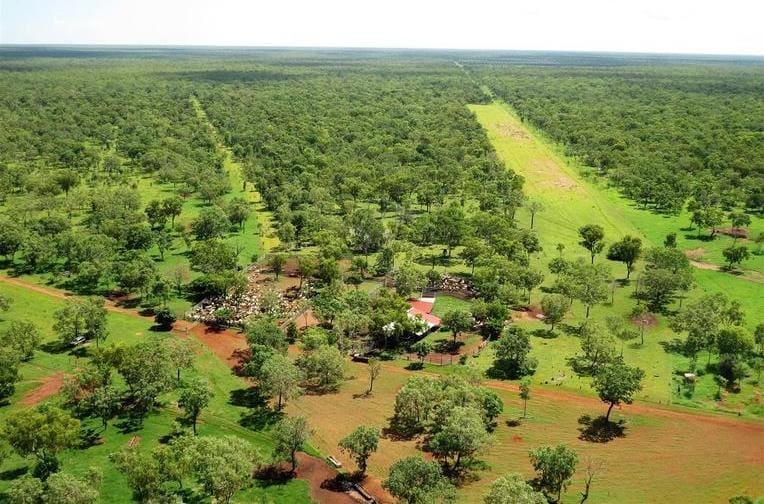
Lakefield Station, on the Sturt Plateau, is one of 22 pastoral holdings currently for sale in the Northern Territory
MORE than five million hectares of pastoral land is being marketed in the Northern Territory at present, but it has been a slow year so far on the sales front, with only three cattle stations changing hands in 2018.
In April, the 3240sq km Maryvale Station, south of Alice Springs, sold to businessman Viv Oldfield for $15 million including 10,000 head of cattle.
Last month, the 809sq km Mt McMinn Station in the Roper River district sold for a reported $7.5m to a South African family and just last week, Katherine’s Twin Rivers Station sold to a Chinese buyer for $6 million – more than double its 2017 sale price.
According to Beef Central’s property listings for sale, there are 22 pastoral holdings currently on the market in the NT, including seven in the Consolidated Pastoral Co pastoral portfolio listing:
- 607sq km Margaret Downs (Sturt Plateau district)
- 3760sq km Kalala (Daly Waters)
- 586sq km Tarlee (Mataranka, Sturt Plateau)
- 1789sq km Legune (Victoria River District)
- 602sq km Middle Creek (Sturt Plateau)
- 895sq km Flying Fox (Roper District)
- 3318sq km Kiana (Tablelands/NT Gulf region)
- 678sq km Sturt Downs (Katherine/Sturt Plateau)
- 5001sq km Tanumbirini (Roper Gulf Shire)
- 593sq km Forrest Hill (Sturt Plateau)
- 2027ha Kingfisher Station (Douglas/Daly)
- 581sq km Lakefield Station (Sturt Plateau)
- 652sqkm Mathison Station (Katherine)
- 2310sq km Yambah Station (Alice Springs)
- 74sq km Carbeen Park (Katherine)
CPC’s NT holdings:
- 4142sq km Auvergne Station (Katherine)
- 1788sq km Bunda Western (VRD)
- 4454sq km Dungowan (Katherine)
- 2304sq km Kirkimbie (VRD)
- 3791sq km Manbulloo (Katherine)
- 10,331sq km Newcastle Waters (West Barkly)
- 2455sq km Ucharonidge (Tennant Creek)

Frank Peacocke
Herron Todd White’s Frank Peacocke believes NT cattle producers are becoming more aware that now must be a reasonable time to dispose of property, given the combination of record pastoral prices, declining live export prices, the mothballing of the Livingstone Beef abattoir and a forecast increase in the cost of borrowing money.
“However, current asking prices for a fair proportion of pastoral country in the north of the Territory appears to be attracting less interest and vendors may need to be more price realistic to achieve a sale.”
In 2017, the property market ran up and peaked – effectively doubling prices. Today, there is a question mark about sustainability of those prices going forward, as well as the sustainability of live export prices.
Mr Peacocke, who has been analysing historical sales, said beast area values were currently at unprecedented levels.
“No one thought we could return to those levels described as ‘ridiculous money that would never happen again.’ The 2018 property market has exceeded those highs,” he said.
Has the market peaked?
With the significant amount of northern pastoral land now on the market, Mr Peacocke believes the next couple of sales are likely to be more telling of whether the grazing land market (in the north of the NT at least) has peaked.
“There has been such a strong rise in values over the last three years, there is a perception that the market is nearing the peak. Some of the asking prices might be too high – those properties have been sitting on the market for some time,” he said.
“The cattle market is not as strong and there is a perception that prices could come under downward pressure. Vendors are keeping their prices set for their cattle stations. Conversely, those wishing to purchase properties don’t want to buy at the top of the market, and not make any money.”
Mr Peacocke attributes the current market slowness to industry economics – cattle prices, abattoir closures and unprecedented prices for cattle stations.
“I look at the asking prices for some of those properties that have been on the market for a while, and they are a bit ambitious. Local pastoralists seeking to buy those blocks, can’t stomach the asking price.”
He said potential station purchasers were also becoming more discerning about the type of station they bought.
“They are looking at quality properties that have proven a production history with records that are transparent – and that is the problem. Some vendors aren’t forthcoming with accurate stocking rates, rainfall records or operational history.”
“I have heard of buyers backing out of deals because they can’t get the information they are seeking from vendors. Potential purchasers asking us to do due diligence are frustrated by the lack of information and as a valuer, I have experienced that as well,” Mr Peacocke said.
He believes transparency equates to confidence.
“It is difficult to get that information – some foreign investors are frustrated, and as a consequence are pulling out of deals. So, it is not only the type of property that is attracting buyers, it is also what goes along with the property – the goodwill.”
Domestic interest
Geoff Warriner, a senior consultant in CBRE’s Agribusiness Transactions team, said the Chinese were still in the market, but the domestic demand was stronger.
“There is plenty of interest and competition from locals. Territory places selling for around $20m are more likely to be sold to domestic buyers these days. Over the last three years, cattle producers have made a lot of money and are cashed up,” Mr Warriner said.
“Purchases by neighbours are much more common compared to 2013, when cattle prices were half what they are today, and all the property sales were receiver sales. Back then, the agricultural sector was on the nose and offshore investors took advantage of the distressed market,” Mr Warriner said.
Andy Gray from Ruralco Property Territory Rural in Darwin agrees that Chinese interest is not as evident as it was earlier.
“There is still strong international interest, but it is not necessarily Chinese. Inquiry is coming from a host of other nations, especially South Africa and Vietnam.”
Rawdon Briggs, the head of rural and agribusiness and transaction services at Colliers International, said interest in NT properties was certainly not a one-horse race.
“There is a mix of interest from offshore and onshore investors. Twelve months ago, there was more foreign interest and very little domestic. It is a good mixture this time – privates as well as corporates.”
- Next week: In part-two of this series, property agents offer comment on whether the public sale of Australia’s largest privately-owned cattle company (CPC) is contributing to the slow market in the north.
